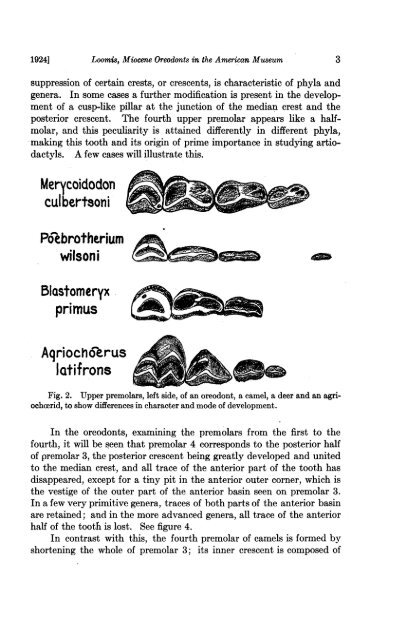View/Open - American Museum of Natural History
View/Open - American Museum of Natural History
View/Open - American Museum of Natural History
Create successful ePaper yourself
Turn your PDF publications into a flip-book with our unique Google optimized e-Paper software.
1924] Loomis, Miocene Oreodonts in the <strong>American</strong> <strong>Museum</strong><br />
3<br />
suppression <strong>of</strong> certain crests, or crescents, is characteristic <strong>of</strong> phyla and<br />
genera. In some cases a further modification is present in the development<br />
<strong>of</strong> a cusp-like pillar at the junction <strong>of</strong> the median crest and the<br />
posterior crescent. The fourth upper premolar appears like a halfmolar,<br />
and this peculiarity is attained differently in different phyla,<br />
making this tooth and its origin <strong>of</strong> prime importance in studying artiodactyls.<br />
A few cases will illustrate this.<br />
Merycoidodon<br />
cut bertsoni'<br />
P6ebrothe.rium<br />
wilsoni<br />
Blistomeryx<br />
primus<br />
Aqrioch6erus<br />
lact ifrons<br />
Fig. 2. Upper premolars, left side, <strong>of</strong> an oreodont, a camel, a deer and an agriochoerid,<br />
to show differences in character and mode <strong>of</strong> development.<br />
In the oreodonts, examining the premolars from the first to the<br />
fourth, it will be seen that premolar 4 corresponds to the posterior half<br />
<strong>of</strong> premolar 3, the posterior crescent being greatly developed and united<br />
to the median crest, and all trace <strong>of</strong> the anterior part <strong>of</strong> the tooth has<br />
disappeared, except for a tiny pit in the anterior outer corner, which is<br />
the vestige <strong>of</strong> the outer part <strong>of</strong> the anterior basin seen on premolar 3.<br />
In a few very primitive genera, traces <strong>of</strong> both parts <strong>of</strong> the anterior basin<br />
are retained; and in the more advanced genera, all trace <strong>of</strong> the anterior<br />
half <strong>of</strong> the tooth is lost. See figure 4.<br />
In contrast with this, the fourth premolar <strong>of</strong> camels is formed by<br />
shortening the whole <strong>of</strong> premolar 3; its inner crescent is composed <strong>of</strong>

















